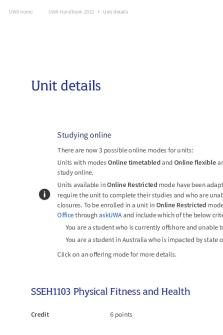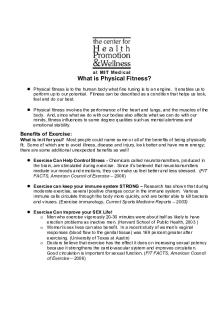Physical Fitness TEST PRE PDF

| Title | Physical Fitness TEST PRE |
|---|---|
| Course | Philippine Public Administration |
| Institution | Ateneo de Davao University |
| Pages | 14 |
| File Size | 696 KB |
| File Type | |
| Total Downloads | 13 |
| Total Views | 176 |
Summary
FOR PE...
Description
Activity 1: PAR Q & YOU (A Questionnaire for People Aged 15 to 69) Instruction: This questionnaire will help you and your family members check if moderate to vigorous physical activity is safe for all of you. Put (/) for YES and (x) for NO in the box that corresponds to you and your family’s answers. If you answer “No” to all the questions, you are ready to engage in an active lifestyle. If you answer “Yes” to any question, you need to talk to your family physician about you or your family member’s condition before participating in any physical activities. If you are planning to become much more physically active than you are now, start by answering the seven questions in the box below. If you are between the ages of 15 and 69, the PAR-Q will tell you if you should check with your doctor before you start. If you are over 69 years of age, and you are not used to being very active, check with your doctor. Common sense is your best guide when you answer these questions. Please read the questions carefully and answer each one honestly: check YES orNO. (https://www.fgcu.edu/mariebcollege/rehabilitationsciences/exercisescience/files/EIM -PAR-Q1-ada.pdf) QUESTIONS
Father
Mother
Sister
Brothe r
You
1. Has your doctor ever said that you have a heart condition and that you should only do physical activity recommended by a doctor? 2. Do you feel pain in your chest when you do physical activity? 3. In the past month, have you had chest pain when you were not doing physical activity? 4. Do you lose your balance because of dizziness or do you ever lose consciousness? 5. Do you have a bone or joint problem (for example, back, knee or hip) that could be made worse by a change in your physical activity? 6. Is your doctor currently prescribing drugs (for example, water pills) for your blood pressure or heart condition? 7. Do you know of any other reason why you should not do physical activity?
Activity 2: Physical Fitness Tests (Health-related) The physical fitness test is a set of measures designed to determine one’s level of physical fitness. These tests will give you a deeper understanding of the importance of exercise in developing total fitness and wellness. Record the result on the table provided in the next succeeding pages. Guidelines: 1. Do the following to prepare for the tests.
-
Review the procedure in conducting the Physical Fitness Tests. Wear the appropriate attire. Do the warm-up exercises on your own or with your partner. Re-orient yourself on the proper execution of the tests and recording of test results. Go through the test without exerting maximum effort. Observe safety.
-
2. Perform the tests with a partner or assistant. 3. Record your test results. Suggested sequence in administering and performing the tests. Day 1
Day 2
BMI
Basic Plank
3-minute Step Test
Push up
Zipper Test
Sit and Reach
HEALTH-RELATED FITNESS TESTS A. Body Mass Index (BMI) - is the body’s relative amount of fat to fat-free mass. Formula for computing Body Mass Index Weight [kg] Height [m]2 Example:
_30_ = _30_ (1.2)2 1.44
Classification: Below 18.5 18.6 – 24.9 25 – 29.9 30.0 – Above
= 20.83 (Normal)
Underweight Normal Overweight Obese
A.1. Weight – the heaviness or lightness of a person. Equipment Weighing or bathroom Scale in your house or in your Barangay Health Center calibrated properly. Procedure For the test taker: a. Wear light clothing before weighing.
Module 1
PE 111 – Health and Self-Testing Activities
1
b. On bare feet, stand erect and still with weight evenly distributed on the center of the scale. For the partner: a. Before the start of weighing, adjust the scale to zero point. b. Record the score in kilograms. Scoring – record body mass to the nearest 0.5 kilograms A.2. Height – it is the distance between the floor to the top of the head in standing position. Equipment 1. Tape measure laid flat to a concrete wall. The zero point starts at the bottom of the floor. 2. L-square or ruler; and 3. An even and firm floor and flat wall. Procedure For the test taker: a. Stand erect on bare feet with heels, buttocks and shoulders pressed against the wall where the tape measure is attached. For the partner: a. Place the L-square or ruler against the wall with the base at the top of the person being tested. b. Record the score in meters. Scoring – record standing height to the nearest 0.1 centimeter 1 meter = 100 centimeter Waist Circumference Waist circumference is a good predictor of visceral fat which contributes more risk of cardiovascular disease and diabetes than fat located in other areas of the body. Equipment: tape measure Procedure: For the test taker: a. Wear light clothing before having your waist circumference taken. b. On bare waist, stand erect and wrap the tape measure around your waist. For your partner: a. Record the score in centimeters. Standard Module 1
PE 111 – Health and Self-Testing Activities
2
Men Risk Very High High Normal Low Very Low
Centimeter >120 100 – 120 102 80 – 99 47 39.5 – 47 40 31.5 – 39 110 >43.5 90 – 109 35.5 – 43 88 34.6 70 – 89 28.3 – 35...
Similar Free PDFs

Physical Fitness TEST PRE
- 14 Pages

Physical Fitness TEST Score CARD
- 1 Pages

Physical Fitness
- 4 Pages

Physical Fitness Chapter 1
- 6 Pages

Physical Fitness Quiz 1
- 2 Pages

Physical Fitness Finals
- 83 Pages

Chapter 1 - pre test
- 43 Pages

PRE-COMMISSIONING TEST
- 1 Pages

ART Appreciation - PRE-TEST
- 1 Pages
Popular Institutions
- Tinajero National High School - Annex
- Politeknik Caltex Riau
- Yokohama City University
- SGT University
- University of Al-Qadisiyah
- Divine Word College of Vigan
- Techniek College Rotterdam
- Universidade de Santiago
- Universiti Teknologi MARA Cawangan Johor Kampus Pasir Gudang
- Poltekkes Kemenkes Yogyakarta
- Baguio City National High School
- Colegio san marcos
- preparatoria uno
- Centro de Bachillerato Tecnológico Industrial y de Servicios No. 107
- Dalian Maritime University
- Quang Trung Secondary School
- Colegio Tecnológico en Informática
- Corporación Regional de Educación Superior
- Grupo CEDVA
- Dar Al Uloom University
- Centro de Estudios Preuniversitarios de la Universidad Nacional de Ingeniería
- 上智大学
- Aakash International School, Nuna Majara
- San Felipe Neri Catholic School
- Kang Chiao International School - New Taipei City
- Misamis Occidental National High School
- Institución Educativa Escuela Normal Juan Ladrilleros
- Kolehiyo ng Pantukan
- Batanes State College
- Instituto Continental
- Sekolah Menengah Kejuruan Kesehatan Kaltara (Tarakan)
- Colegio de La Inmaculada Concepcion - Cebu






